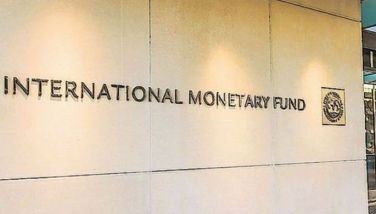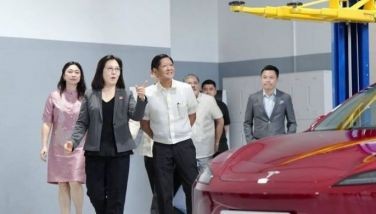DPWH asked to explain cost overruns in interchange proj
December 1, 2003 | 12:00am
The Investment Coordination Committee (ICC) has directed the Department of Public Works and Highways to explain the cost overruns in the P2.7-billion Metro Manila Interchange Project as it deferred its decision on some P1-billion additional funding for the project.
The ICC met last week and approved the extension of the loan period for the interchange project and the Light Railway Transit (LRT) Line 2 project. However, the committee refused to allow DPWH to earmark another P1 billion for the interchange project without explaining the cost overruns.
ICC sources explained that the interchange had an approved cost of P2.7 billion which was funded by the government (P1.7 billion) and a P1.036-billion loan from the Japan Bank for International Cooperation (JBIC).
The project, however, encountered design difficulties and right-of-way problems that the DPWH has not been able to resolve. The delays and various other problems led to a P1-billion increase in the initial cost of the project, according to sources.
An ICC source explained that the DPWH was "able to obtain" an additional P1 billion to finance the cost overruns, but the ICC refused to approve the expenditure until the cost overruns have been explained to the satisfaction of the committee.
"Foreign-assisted projects have been giving us problems in the budget so the ICC is being very sensitive to things like this," said the source.
At least one portion of the interchange project, according to the source, ended up costing more because of a change in the design because the DPWH had to extend the length of the depressed portion of the interchange.
Meanwhile, the source said the ICC approved the one-year extension of the MMI project and the 18-month extension of the LRT2 project as both projects faced delays due to design changes and unresolved right-of-way problems.
ICC said the Metro Manila Interchange project needed the extension because of the delays in the construction of the interchange at the Circumferential Road 5 (C5) and Boni Avenue.
The project itself involves the construction of three major interchanges. The two other interchanges are the EDSA-Quezon Avenue interchange and the Ortigas-C5 Interchange.
Of the three, only the EDSA-Quezon Avenue interchange has been completed although the Ortigas-C5 interchange was scheduled for completion in January 2004.
According to ICC sources, the C5-Boni interchange has been problematic because of right-of-way problems that the Department of Public Works and Highways (DPWH) has not been able to resolve.
Sources said the DPWH had originally asked for an extension of the project until September 2004, but this was rejected by the ICC which extended the project only up to June 2004 before the opening of the schoolyear.
The interchange project also included the detailed engineering design for four more interchange projects: EDSA-North Avenue/West Avenue, EDSA-Rooosevelt, C5-Kalayaan and C5-Lanusa/Julia Vargas.
The interchange project is partly funded out of a loan from the Japan Bank for International Cooperation (JBIC) while the government funded P1.72-billion worth of counterpart financing.
The LRT project, on the other hand, got another 18-month extension. The 13.8-kilometer extension of the LRT Line 1 was supposed to include the construction of 11 stations headed in the East-West direction from Santolan in Quezon City to CM Recto.
LRT 2 had an approved cost of P26 billion with P19.7 billion coming from JBIC and the rest from the national government. The project was supposed to have been completed in April 2004 but the ICC said it would not be completed until after a year or so.
The ICC met last week and approved the extension of the loan period for the interchange project and the Light Railway Transit (LRT) Line 2 project. However, the committee refused to allow DPWH to earmark another P1 billion for the interchange project without explaining the cost overruns.
ICC sources explained that the interchange had an approved cost of P2.7 billion which was funded by the government (P1.7 billion) and a P1.036-billion loan from the Japan Bank for International Cooperation (JBIC).
The project, however, encountered design difficulties and right-of-way problems that the DPWH has not been able to resolve. The delays and various other problems led to a P1-billion increase in the initial cost of the project, according to sources.
An ICC source explained that the DPWH was "able to obtain" an additional P1 billion to finance the cost overruns, but the ICC refused to approve the expenditure until the cost overruns have been explained to the satisfaction of the committee.
"Foreign-assisted projects have been giving us problems in the budget so the ICC is being very sensitive to things like this," said the source.
At least one portion of the interchange project, according to the source, ended up costing more because of a change in the design because the DPWH had to extend the length of the depressed portion of the interchange.
Meanwhile, the source said the ICC approved the one-year extension of the MMI project and the 18-month extension of the LRT2 project as both projects faced delays due to design changes and unresolved right-of-way problems.
ICC said the Metro Manila Interchange project needed the extension because of the delays in the construction of the interchange at the Circumferential Road 5 (C5) and Boni Avenue.
The project itself involves the construction of three major interchanges. The two other interchanges are the EDSA-Quezon Avenue interchange and the Ortigas-C5 Interchange.
Of the three, only the EDSA-Quezon Avenue interchange has been completed although the Ortigas-C5 interchange was scheduled for completion in January 2004.
According to ICC sources, the C5-Boni interchange has been problematic because of right-of-way problems that the Department of Public Works and Highways (DPWH) has not been able to resolve.
Sources said the DPWH had originally asked for an extension of the project until September 2004, but this was rejected by the ICC which extended the project only up to June 2004 before the opening of the schoolyear.
The interchange project also included the detailed engineering design for four more interchange projects: EDSA-North Avenue/West Avenue, EDSA-Rooosevelt, C5-Kalayaan and C5-Lanusa/Julia Vargas.
The interchange project is partly funded out of a loan from the Japan Bank for International Cooperation (JBIC) while the government funded P1.72-billion worth of counterpart financing.
The LRT project, on the other hand, got another 18-month extension. The 13.8-kilometer extension of the LRT Line 1 was supposed to include the construction of 11 stations headed in the East-West direction from Santolan in Quezon City to CM Recto.
LRT 2 had an approved cost of P26 billion with P19.7 billion coming from JBIC and the rest from the national government. The project was supposed to have been completed in April 2004 but the ICC said it would not be completed until after a year or so.
BrandSpace Articles
<
>
- Latest
- Trending
Trending
Latest




























